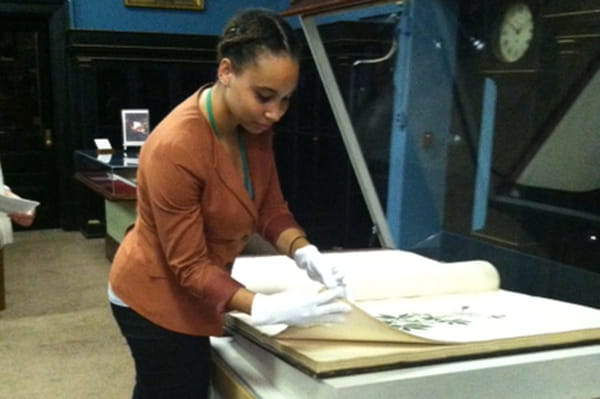Mica Matlack's Job is to Turn Pages in a Book, and it Might Make You Jealous

She grew up in Audubon, N.J, but Mica Matlack never really thought about her hometown’s name until she started her co-op at the Academy of Natural Sciences of Drexel University. The junior communications major received a startling history lesson when she learned part of her responsibilities as the library and archives co-op was to officiate the daily page turning of famed ornithologist and artist John James Audubon’s magnum opus, “The Birds of America”—the same Audubon after which her town is named.
The famed Franco-American author, artist and naturalist collected and drew birds from the area’s diverse woods and small streams from 1829 to 1832, and some of those bird drawings appeared in “The Birds of America.” The birds were later reproduced on street signs and other public spaces in the town, which was later renamed in Audubon’s honor.
“It’s like throughout my life I encountered Audubon without knowing it,” Matlack said.
“Birds of America” has been considered one of the greatest works of scientific art, natural history and bookmaking since the 19th century. Audubon’s lifelong love of birds propelled him on a quest to paint every bird in North America, and his desire eventually helped him discover 25 new species and 12 new subspecies of birds. Audubon gained even more acclaim for his breathtaking images that showed birds in their natural habits, and in their natural size, at a time when birds were commonly depicted in flat, two-dimensional illustrations.
Though Audubon’s reputation as a boisterous liar and arrogant scoundrel originally cost him his membership at the Academy, the institution was one of the original subscribers of “The Birds of America.” Subscribers paid $1,000 (about $40,000 today) to receive periodic sets of five prints from 1827 to 1838. Audubon produced 435 total prints of 1,065 birds of 489 species.
Now, about 120 copies of the original 200 editions Audubon created remain intact—one of which sold for $10 million at a 2010 auction—and Matlack gets to interact with the Academy’s copy every day.
“It’s the most expensive thing I have ever touched in my life,” she joked.
Now, the institution is the only local institution that turns a page of the famed book once each weekday. One private copy is kept in a custom-made case in the boardroom at the American Philosophical Society in Philadelphia. The other two copies available to the public in the area are turned once a month at the University of Pennsylvania’s library and Mill Grove, Audubon’s home-turned-museum located in Audubon, Pa. (the second and last city named after Audubon). The Academy’s openness with the prized possession means Matlack always has an audience for her daily presentations.
At a time when many employees are struggling to beat the 3 p.m. slump, Matlack prepares for her big moment. Every day at 3:15 p.m., donning special gloves, she carefully turns a massive 26-by-38-inch linen-backed page to reveal a new hand-colored illustration. Anyone visiting or working at the Academy can attend the event and listen as Matlack holds a discussion about the author, his work and the day’s featured bird.
Matlack prepares for the demonstration by researching the upcoming bird in Audubon’s personal journals and online resources. Audubon’s reputation in ornithology and scientific fields means that sometimes her visitors include members of the Academy’s malacology and ornithology departments, as well as other bird lovers, bird experts and scientists. And since the Ornithology Department's collection is one of the 10 largest and most complete bird collections in the world, sometimes Matlack says it can be “really nerve-wracking” when she’s talking to the experts.
“But sometimes there are these little kids who have never heard of Audubon and are excited to see something that, in their eyes, is really, really, really, really old,” she said.
Matlack is used to working with old and unusual books in the Academy’s enormous climate-controlled library. She often scans books and prepares them to be loaned to other libraries.
Some of the books are more than 300 years old or are written in different languages, but that’s no trouble for Matlack. She speaks Spanish, Chinese, Korean, Vietnamese, French and Russian, in addition to her native English. Her first time out of the country was a summer term spent at a Korean university, and she says she is now almost fluent in Korean. Now concentrating in global journalism, Matlack taught herself the languages by enrolling in free online classes and watching foreign movies and television shows.
Her impressive language background helped Matlack secure her co-op at the Academy, and she hopes she will be able to use her love for languages and other countries after graduation. She’s still trying to figure out what that might entail, though.
“Whatever it is, I want to work with people and communicate or travel,” she said.
But for now, she’s content to work with the Academy’s visitors every day to talk about Audubon’s own travels and adventures.
In This Article
Drexel News is produced by
University Marketing and Communications.

